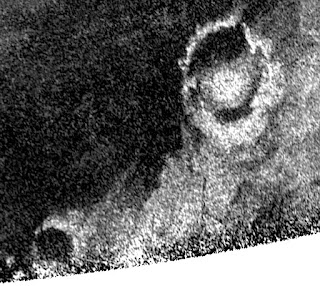Cat #------Name----Certainty---Long---Lat-----Diameter---Radar Swath---------------------------------------------------------
None Paxsi
-----1
-- 341.2W 5N
-- 120 km
-- T108
Above: Discovery images from VIMS.
Below: T108 Radar image showing bright-rimmed, crater with dark floor. Crater is elongated north to south, and central peak complex is significantly offset to south. Center of peak is circular and bright, surrounded by apron of fainter material with radial lineations - perhaps due to downslope movement.
At bottom left is another bright-rimmed, dark-floored feature that may be another impact crater.
Publications:
Buratti, B.J. and 9 others (2012) A newly discovered impact crater in Titan's Senkyo: Cassini VIMS observations and comparison with other impact features.
Planetary and Space Science 60, 18-25.


















